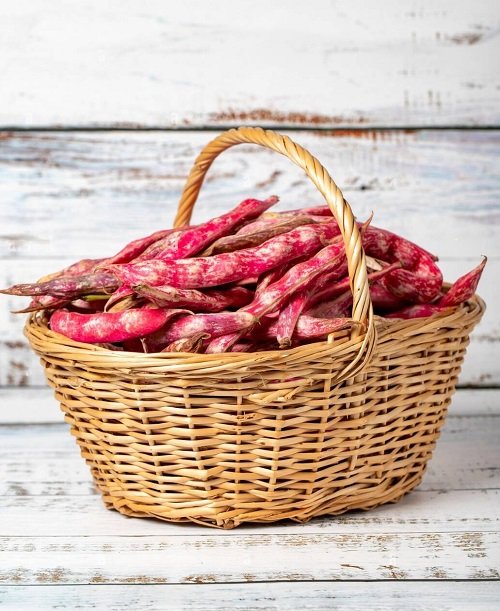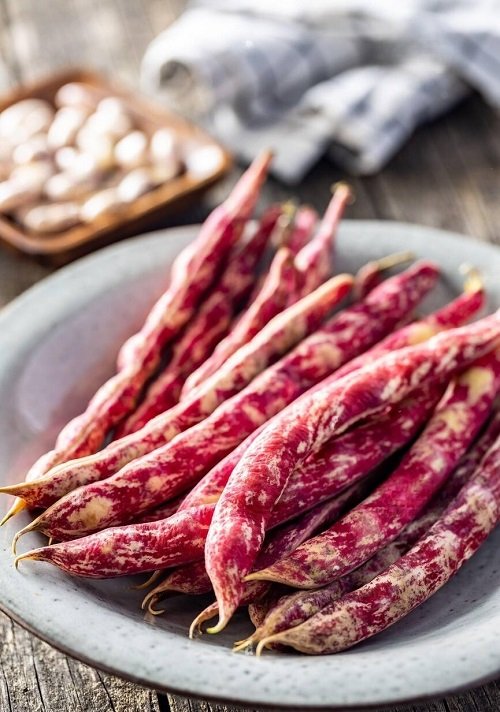Growing Pinto Beans in your garden and containers is quite an experience! Join us as we share all the important details!
Growing pinto beans isn’t just about gardening; it’s about savoring the rewards of patience, care, and a connection with nature. Join us on this journey from seed to table as we unlock the secrets of cultivating these nutritious legumes. Scroll down and embrace the joy of growing your own food from the ground up.
Pinto Beans Information
Pinto beans, scientifically known as Phaseolus vulgaris, belong to the legume family. These humble beans trace their roots back to Central and South America, where they’ve been cultivated for thousands of years. Today, they’re a beloved staple in many cuisines worldwide.
Pinto bean plants are relatively compact, reaching about 18-24 inches in height. They boast lush green foliage with leaves that are typically heart-shaped. Pinto beans are named for their speckled appearance, with beige or light brown backgrounds and mottled patches of reddish-brown. These beans are small, oval-shaped wonders packed with nutritional value, making them a popular choice for both home cooks and chefs.
One fascinating aspect of pinto beans is their ability to fix nitrogen in the soil, enhancing soil fertility. This makes them an excellent choice for crop rotation in sustainable farming practices. Additionally, pinto beans are an excellent source of protein, fiber, and essential nutrients like iron and folate, making them a nutritious addition to any diet.
Propagating Pinto Beans
Ways to Propagate Pinto Beans
- Seed Planting
- Direct Sowing
- Transplanting
The Most Popular and Reliable Method: Sowing
Direct sowing is often the most reliable method for propagating pinto beans. This is because pinto beans, like many other legumes, have a taproot system and do not transplant well. When you directly sow the seeds into their final growing location, they can establish their roots without disruption, leading to healthier and more robust plants.
Steps for Growing Pinto Beans by Sowing
Wonder How does pinto beans grow? And how you can do it? Here are the steps you should follow.
- Select a sunny spot in your garden with well-drained soil. Pinto beans thrive in full sun, so aim for at least 6-8 hours of sunlight each day.
- Ensure the soil is loose, well-draining, and enriched with organic matter like compost. This provides a fertile foundation for your pinto beans.
- Choose high-quality pinto bean seeds. Look for seeds from a reliable source or consider using seeds saved from a previous successful crop.
- Sow the seeds about 1 to 1.5 inches deep, spacing them 2-4 inches apart in rows. Leave around 18-24 inches between each row to allow for growth.
- Water the seeds immediately after planting to help settle the soil around them. Keep the soil consistently moist, but avoid waterlogging, as pinto beans don’t tolerate waterlogged conditions.
- Applying a layer of mulch can help retain soil moisture and reduce weed growth. Organic mulch, such as straw or shredded leaves, works well.
Pinto beans are typically ready for harvest when the pods have filled out, and the beans inside are plump. You can leave the pods on the plant to dry for a few weeks before shelling the beans.
Once harvested, pinto beans can be cooked and enjoyed in a variety of dishes, from soups and stews to salads and side dishes.
Advantages of Sowing
- Taproot System: Pinto beans have a taproot system, which means they develop a long, central root that doesn’t transplant well.
- Reduced Stress: Direct sowing avoids the stress and potential damage to the root system that can occur during transplanting.
- Healthy Growth: Planting seeds directly in their final location allows beans to establish strong root systems and healthier overall growth.
Choosing a Container for Pinto Beans
When selecting a container for Growing pinto beans, opt for a pot that is at least 12 to 16 inches deep and has a diameter of about 10-12 inches or more. This provides ample room for the beans to develop their root systems.
Ensure the container has good drainage to prevent waterlogging.
Requirements for Growing Pinto Beans
Sunlight
Pinto beans thrive in full sun, so choose a sunny spot in your garden that receives at least 6-8 hours of sunlight daily. They love basking in the warmth and light, which helps them produce an abundant harvest.
Place the pot in a location that receives bright, indirect sunlight when Growing pinto beans indoors. A south-facing window is often ideal for providing sufficient light.
Soil
Plant your pinto beans in well-draining soil that’s rich in organic matter. Loose, fertile soil provides a perfect foundation for their growth.
Adding compost or organic matter can improve soil quality, ensuring your beans have the nutrients they need to flourish.
Water
Keep the soil consistently moist but not waterlogged. Pinto beans prefer even moisture levels, especially during their flowering and pod-setting stages.
Watering at the base of the plants in the morning helps prevent diseases, as wet foliage can lead to issues like mildew.
Temperature
Pinto beans are warm-weather plants, so they thrive in temperatures between 70°F and 80°F (21°C – 27°C). They don’t tolerate frost, so wait until after the last frost date in your area before planting.
Warmer temperatures encourage healthy growth and bean development.
Pinto Bean Care
Fertilizer
Pinto beans generally don’t demand heavy fertilization. However, you can provide a balanced, all-purpose fertilizer at planting time or when they begin flowering if your soil lacks nutrients.
In spring, incorporate balanced fertilizer at planting. During early and late summer, side-dress with nitrogen-rich fertilizer, around 1 to 2 tablespoons per plant, to bolster flowering, pod-setting, and bean growth. Avoid over-fertilizing, as excessive nitrogen can lead to lush foliage but fewer bean pods.
Overwintering
Pinto beans are typically grown as annuals, and they don’t overwinter in cold climates. When the growing season ends and temperatures drop, the plants will naturally wither and die.
If you want to save seeds or if you’re in a mild climate, you can leave some pods on the plant to fully mature and dry.
Pests
- Aphids: Small, sap-sucking insects that cluster on leaves, causing curling, yellowing, and reduced growth.
- Spider Mites: Tiny arachnids that spin webs on plants and feed on leaves, causing stippling and discoloration.
- Bean Leaf Beetles: Beetles that chew on bean leaves, leaving behind skeletonized foliage and reducing photosynthesis.
- Mexican Bean Beetle: Similar to ladybugs but destructive, they devour bean leaves and can defoliate plants rapidly.
Diseases
- Anthracnose: A fungal disease causing dark, sunken lesions on leaves, stems, and pods, leading to reduced yields.
- Rust: A rust-colored fungal growth on bean leaves, reducing photosynthesis and weakening the plant.
- Powdery Mildew: A white, powdery fungus that appears on leaves, hindering photosynthesis and overall plant health.
- Bacterial Blight: Caused by bacteria, it results in angular, water-soaked lesions on leaves and pods, potentially leading to plant death.
Harvesting Pinto Beans
Now that you know How to grow a pinto bean, here’s how you can reap the rewards.
Days to Harvest
The number of days to harvest pinto beans can vary, but you can start checking for readiness around 80 days after Growing pinto beans. Keep in mind that some beans may take a bit longer, closer to the 100-day mark.
Signs that the Beans are Ready to be Picked
Determining the right time to pick your pinto beans is crucial for optimal flavor and texture. Here are some signs that indicate they’re ready for harvest.
- The bean pods have plumped up and are well-filled.
- The pod’s skin has become slightly papery and may have started to change color from green to yellow or beige.
- When you gently squeeze the pods, you can feel the beans inside, indicating they’ve reached their full size.
- If you open a pod and the beans inside are fully formed and firm, it’s time to start harvesting.
Storing Pinto Beans
Once you’ve harvested your pinto beans, it’s essential to store them properly to maintain their quality. Here’s how to do it.
- Allow freshly picked beans to air dry for a few weeks in a cool, dry place to reduce moisture content.
- Once thoroughly dry, store the beans in airtight containers or vacuum-sealed bags to prevent moisture and pests from getting in.
- Keep the containers in a cool, dark, and dry location, such as a pantry or cellar, to ensure long-term storage without flavor loss or spoilage.








